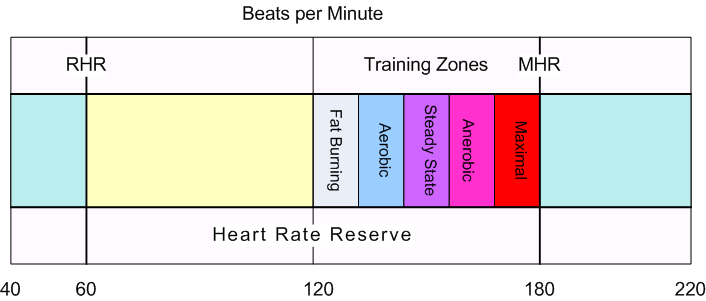
|
Enquiries: contactATarmidaleDOTinfo
Maximum Heart Rate Calculate MHR Calculate HRR and Zones
It has long been accepted as an approximation, that your Maximum Heart Rate (MHR) starts out at 220 beats per minute and falls by one beat each year. Therefore, you can calculate your Maximum Heart Rate by deducting your age from 220. So a good estimate of Maximum Heart Rate for a 40 year old is 180 (220-40 (age)) and for a 20 year old is 200 (220-20). However, the relationship is not perfectly linear and as we age, especially if we maintain a high level of fitness, our Maximum Heart Rate falls by less than one beat each year. A closer approximation is to accept the one year one beat rule until you reach 30. After 30 it is only .5 a beat per year. This may be summarized by the following formula: Maximum Heart Rate equals:
For example, at age 50 the Maximum Heart Rate equals: 190-(50-30)/2=180 bpm |
It is important to understand that this is an approximation, as each of us is biochemically unique. It is, however, a good starting point. Apart from the fact that we are all different, there are a number of other factors that impact upon our Maximum Heart Rate including:
-
The type of sport: The above calculations relate to running. MHR for swimming and cycling may be lower by 5 to 10 bps.
-
Your level of Activity: When you are younger high levels of activity tend to lower your maximum heart rate, however as you get older (over 50) a history of strong training usually results in your ability to maintain your MHR at slightly higher levels
-
Sex: Females tend to have a higher MHR then males
To establish your actual MHR you should do a properly supervised test.
Resting Heart Rate (RHR)
Why is it important to know your MHR? Knowing your MHR, and your RHR (resting heart rate) is essential if you wish to train effectively. Stretching between our MHR and our RHR is our Heart Rate Reserve(HRR). An illustration of these zones for someone with a RHR of 60 and a MHR of 180 is shown in the diagram below.

Where and how often we place ourselves in this heart rate reserve will determine our fitness improvements. You obtain different benefits as you progress through the different subzones in your heart rate reserve. Before we talk about each of these subzones it is important to understand that they are approximations. One zone doesn't finish immediately a certain heart rate is reached. The zones tend to meld into one another. Real benefits from exercise tend to kick in as you move out of the bottom 50% of your heart rate reserve in into your training zones illustrated in the diagram above. Fat Burning (50 to 60%)In this range you are developing your basic endurance and aerobic capacity. This zone is great for burning fat compared to the effort you put in. Other zones will also burn up your fat but you will have to work harder to burn up the same amount. |
Aerobic (60 to 70%)
This zone is great for your cardiovascular system. This helps your muscles become stronger and more efficient and you develop your bodies ability to transport oxygen to (and carbon dioxide away from) your muscles. You should be spending the majority of your training time in this zone.
Steady State (70 to 80%)
Anaerobic (80 to 90%)
Entering this zone is a sign that you have become serious about your sport. In this zone your body develops its ability to handle lactic acid. An anaerobic workout takes place when you are working so hard that your body cannot keep up with the production of fuel and oxygen and so you need to dip into your reserves. When you dip into your reserves you produce numerous waste products - principally lactic acid.
Maximal (over 90%)
Your Heart Rate Reserves and Training Zones
Step by Step Guide for Calculating Your Training Zones
-
What is your Resting Heart Rate (RHR)
What is your Maximum Heart Rate (MHR)
Heart Rate Reserve (HRR) equals MHR-RHR
Fat Burning Range(bottom)=RHR+hrr*.5
Example
RHR 60
MHR 180
HRR=180-60=120
Fat Burning Range(bottom)=60+(120*50%)=120 bps